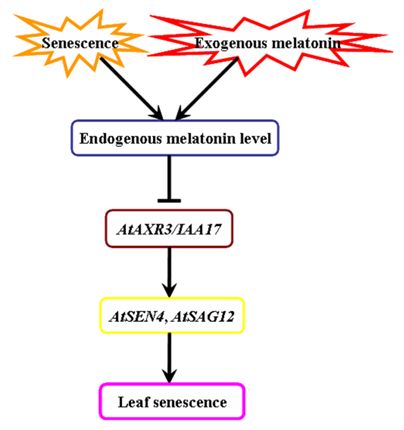IAA17 Positively Modulates Natural Leaf Senescence through Melatonin-mediated Pathway in Arabidopsis
2014-12-09
Leaf senescence occurs not only in detached and stressed leaves, but also is associated with aging. Multiple plant hormones have been confirmed to promote leaf senescence via sophisticated signaling pathways.
Melatonin (N-acetyl-5-methoxytryptamine) is initially identified as an animal hormone involved in various biological process. Then it is found to be a ubiquitous modulator in multiple plant developmental processes and various stress responses. However, the role of melatonin in natural leaf senescence and the underlying molecular mechanism in Arabidopsis remain unclear
Dr. SHI Haitao from Wuhan Botanical Garden and Prof. Russel J. Reiter from The University of Texas Health Science Center, USA cooperated to figure out three questions: the in vivo role of melatonin in natural leaf senescence in Arabidopsis; AUXIN RESISTANT 3 (AXR3)/ INDOLE-3-ACETIC ACID INDUCIBLE 17 (IAA17)’s possible involvement in natural leaf senescence; and the direct relationship of AtIAA17 and melatonin-mediated natural leaf senescence in Arabidopsis.
The investigation of the in vivio role of melatonin in leaf senescence showed that the endogenous melatonin level was greatly induced in a developmental stage-dependent manner, and exogenous melatonin pretreatment delayed leaf senescence significantly in Arabidopsis.
The expression level of IAA17 was significantly downregulated by exogenous melatonin treatment and decreased in a developmental stage-dependent manner in Arabidopsis.
Researchers compared the leaf senescence progressions of wild- type (WT) plants, AtIAA17 knockout mutants, and overexpressing plants under melatonin pretreated and nontreated conditions, results indicated that AtIAA17-overexpressing plants showed earlier leaf senescence with lower chlorophyll content in rosette leaves, while AtIAA17 knockout mutants displayed delayed leaf senescence with higher chlorophyll content than WT plants.
Exogenous melatonin-delayed leaf senescence was greatly alleviated in AtIAA17-overexpressing plants, and AtIAA17-activated senescence-related SENESCENCE 4 (SEN4) and SENESCENCE-ASSOCIATED GENE 12 (SAG12) transcripts might be directly related to melatonin-mediated natural leaf senescence.
This study indicate that AtIAA17 functions as a positive modulator of natural leaf senescence and provides direct link between melatonin and AtIAA17 in the process of natural leaf senescence in Arabidopsis.
Results were published in Journal of Pineal Research (doi: 10.1111/jpi.12188) entitled “INDOLE-3-ACETIC ACID INDUCIBLE 17positively modulates natural leaf senescence through melatonin-mediated pathway inArabidopsis”.

Model depicting the mechanism of AtIAA17 in melatonin-mediated leaf senescence in Arabidopsis (Image by Dr. SHI Haitao)